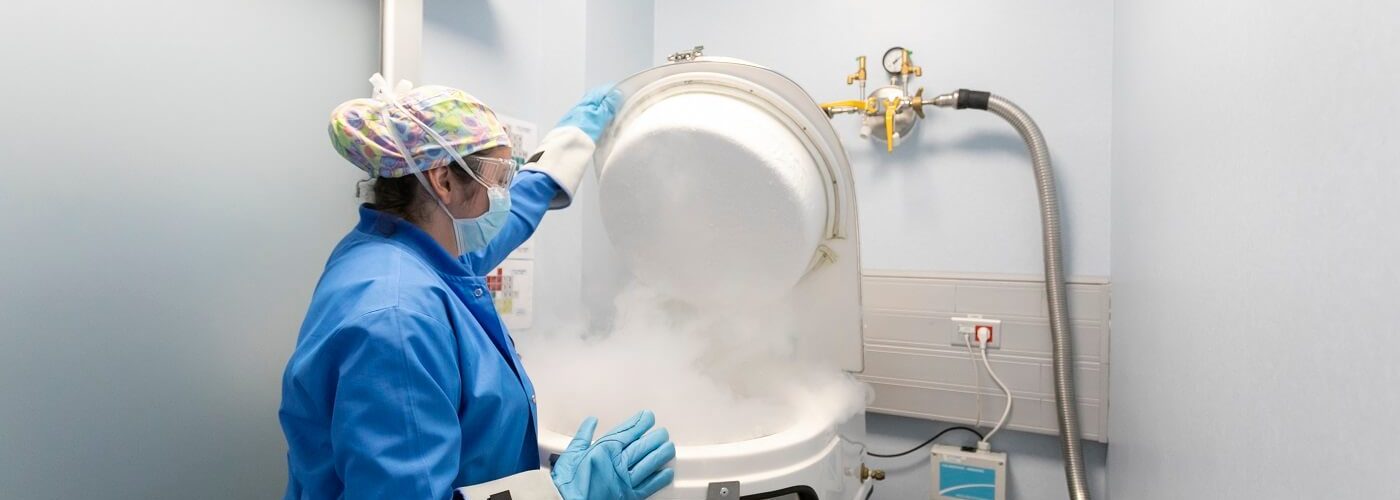
The preservation of fertility through freezing eggs or freezing embryos has, over the past couple of decades, become one of the normal choices that women can make. It’s no longer news that a frozen embryo or egg remains the same ‘age’ as it was when it was frozen. This allows women to press pause on the relentless ticking of the biological clock. Therefore, they can eventually use their frozen genetic material to become parents in their own time. But what are the pros and cons of freezing embryos vs freezing eggs? Once you have decided, whether for social or medical reasons, that you would like to preserve your fertility, this is the next important decision.
In this article we will explore the pros and cons of both methods. We hope to help you decide which is the better option for you.
Freezing embryos vs freezing eggs: how do the processes work?
Whether you’re freezing eggs or embryos, the start of the process is the same. The patient takes hormonal medication for around a 10-day period in order to stimulate the production of multiple eggs. When the eggs have reached an adequate number and maturity, they are retrieved. This is the first step of the well-known in vitro fertilisation (IVF) technique which has been well established for well over 40 years.
In the early days of IVF, only fresh embryos were used for transfer to the patient’s uterus. Quickly technologies which could preserve the embryos for future use. This makes sense, for example if a first try was unsuccessful, or for future family building, were developed.
Embryo freezing process
After the mature eggs have been retrieved, they are fertilized in the laboratory. They are then monitored while they develop for a few days. During this time, embryologists can assess which of them are healthy and capable of developing eventually into a successful pregnancy. When they are at the right stage of development, the healthy embryos are frozen in a process known as vitrification.
The egg freezing process and vitrification
Vitrification is a flash freezing process. The eggs, or oocytes, are immersed in liquid nitrogen at a temperature of -196°C. This makes them ‘glass-like’ or ‘vitrified’. All activity inside the cell, including ageing, ceases. So, when the eggs are thawed, they are exactly the same, and the same age, as when they were vitrified. This differs from the process of slow freezing which was used in the early days of both embryo and egg freezing.
Slow freezing was particularly a problem for the preservation of oocytes, because they are large cells with a high water content. This technique can cause the formation of ice crystals, which damage the egg. This meant in earlier times that generally embryo freezing was more successful than egg freezing. Vitrification avoids this problem so that now, survival rates are very similar. Approximately 95% of embryos survive the freezing process compared with about 90% of eggs. You can learn more about egg freezing and the preservation of fertility by watching our video on the vitrification of oocytes.
What are the differences in freezing embryos vs freezing eggs?
Survival rates of frozen eggs and embryos have become roughly equal. However, some people still have a perception that frozen embryos stand a better chance of ‘success’, i.e., going on to become healthy babies. This may be because it is impossible to test an egg for its genetic quality. Inevitably, not all eggs are capable of being successful fertilized. The only difference here is that the eggs which did not develop successfully into embryos will have been discarded before they are frozen. The same process of discarding those which are not viable would take place following thawing in the case of frozen egs. You would therefore end up with the same number of healthy embryos through either method.
A more significant difference is that if you freeze embryos, you are able to ask for preimplantation genetic testing to be carried out before the freezing process, thus eliminating any embryos which are not healthy. It is not possible to test eggs in this way because of the potential for damage. If you choose to freeze embryos rather than eggs, you have another vital piece of information. You will know in advance how many embryos you have for future use. However, you will have locked yourself in to one crucial decision in advance, which is whose sperm has been used to fertilize the eggs.
Issues to consider when making your choice
In simple terms, you have more options still left open to you when you freeze eggs rather than embryos. This could be a significant factor in a variety of situations:
- If you are single. Or maybe you’re in a relationship which you are not sure is your choice of co-parenting partner. You may want to keep your options open until you’ve found the ‘right’ partner.
- If you were to create embryos with your current partner or using donor sperm, and later met a new partner, you would be unable to use the frozen embryos.
- Some individuals and some faith systems dislike the idea of creating embryos which may not subsequently be used. This is unlikely to be an issue with frozen eggs because of course they do not contain sufficient genetic material to develop.
- On the other hand, if you are in a committed relationship and merely want to delay starting your family, or if you are a single woman using donor sperm and wanting to start your family right away, you may prefer the relative certainty that freezing embryos would give you.
It’s your choice
In the end it’s all down to your individual circumstances and whether you want to keep your options open for future decision-making. Only you can be the judge of that. If you’d like to talk over the issues with us at IVI, we can explain any unresolved questions and help you to make the right choice.





Comments are closed here.